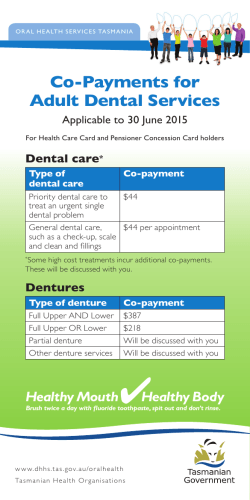
ICD-10 Overview-Dental April 12 Powerpoint
ICD-10 Overview Jacqueline L. Candelaria Program Analyst April 25, 2012 History of ICD-9-CM • World Health Organization (WHO) developed ICD-9 for use worldwide • ICD-9 implemented in the US in 1979 • Expanded number of diagnosis codes • Developed procedure coding system ICD-9-CM Users • ICD-9-CM Diagnoses –used by all types of providers • ICD-9-CM Procedures –used only by inpatient hospitals • Current Procedural Terminology (CPT) –used for all ambulatory and physician procedure reporting What is ICD-9-CM Used for • Calculate payment –Medicare Severity-Diagnosis Related Groups (MS-DRGs) • Adjudicate coverage –diagnosis codes for all settings • Compile statistics • Assess quality Why move from ICD-9 to ICD-10CM • • • • ICD-9-CM is outdated 30 years old-technology has changed Many categories are full Not descriptive enough Why does we need a New Coding System • Quality–would facilitate evaluation of medical processes and outcomes • Reimbursement–would enhance accurate payment for services rendered Benefits of Adopting a New Coding System • Incorporates much greater specificity and clinical information, which results in: • Improved ability to measure health care services • Increased sensitivity when refining grouping and reimbursement methodologies • Enhanced ability to conduct public health surveillance • Decreased need to include supporting documentation with claims Specific changes • Diagnosis Codes (ICD-9 to ICD-10-CM) • From 5 positions (first one alphanumeric, others numeric) to 7 positions, all alphanumeric • From 13,000 existing codes to 68,000 codes • Much greater specificity • Full description and consistency within the code set • Uses modern terminology for descriptions • Creation of combination diagnosis/symptom codes to reduce the number of codes needed to fully describe a condition Structure of ICD-10 ICD-9-CM verses ICD-10-CM ICD-9-CM codes • Dental cariesunspecified-521.00 • Dental caries limited to enamel-521.01 • Dental caries extending into dentine-521.02 • Dental caries extending into pulp-521.03 • Arrested dental caries521.04 ICD-10-CM codes • Dental Caries-unspecifiedK02.9 • •localized destruction of calcified tissue initiated on the tooth surface by decalcification of the enamel of the teeth, followed by enzymatic lysis of organic structures, leading to cavity formation that, if left untreated penetrates the enamel and dentin and may reach the pulp. • •The decay of a tooth, in which it becomes softened, discolored, and/or porous. ICD-9-CM codes verses 1CD-10-CM • • • • • • • • • • • • • • • • • • • • • 521 Diseases of hard tissues of teeth 521.0 Dental caries 521.00 Dental caries, unspecified 521.01 Dental caries limited to enamel Initial caries White spot lesion 521.02 Dental caries extending into dentine 521.03 Dental caries extending into pulp 521.04 Arrested dental caries 521.05 Odontoclasia Infantile melanodontia Melanodontoclasia Excludes: internal and external resorption of teeth (521.40-521.49) 521.06 Dental caries pit and fissure Primary dental caries, pit and fissure origin 521.07 Dental caries of smooth surface Primary dental caries, smooth surface origin 521.08 Dental caries of root surface Primary dental caries, root surface 521.09 Other dental caries • 13 ICD-9- CM codes • 20 ICD-10 CM codes • ICD-10 codes are descriptive • ICD-9 codes a vague and not as descriptive How is IHS Approaching ICD-10 • Established an ICD-10 Steering Committee • Building organizational awareness and commitment • Identified key stakeholders (HIM, IT, Business Office & Revenue Cycle, Clinical) • Evaluating systems and interfaces where codes are captured, exchanged, and reported • Assessing areas of risk • Identifying all systems that assign, utilize or store diagnosis codes • Identifying all processes/policies that utilize diagnosis codes • Identifying all contractors and business partners that rely on diagnosis codes • Obtaining vendor commitment for readiness • Evaluating interface engine support of ICD-10 • Developing a plan and beginning implementation activities ICD-10 – Subgroups • • • • • • Business & Revenue Cycle: Clinical Documentation Improvement: Data Management: Outreach & Awareness: Technical Development: Training: Changes to RPMS for ICD-10 • 64 applications contain ICD-9 Codes • Assessing file structure changes • Field size changes, longer code descriptions • Numeric vs. alpha characters • Logic changes due to the revised code structure • Role of mapping codes being assessed • Interfaced systems with ICD-9 touch points - I/T/U will have to assess any COTS products ICD-10 & ICD-9 FACTS • Both ICD – 9 and ICD – 10 will have to be maintained/used for a period of time • Non-covered entities, like worker’s compensation and auto insurances claims may still use ICD-9 well after the compliance date of 10/1/2013 • Coding and billing backlogs, CMS eligibility changes • Reporting, trending, comparison • MU Core Measures (i.e., hypertension) Clinical and Business Process Changes • Understand this is not just an IT or HIM Project • Organization – wide initiative that impacts • Information Systems – EHR Templates, Pick-lists • Provider Documentation • Clinical Documentation Improvement Program • Coding and Billing • Physician Query Process • Revenue Cycle Management • Contracting, HR, Finance • Quality Improvement, Data Extracts, etc. Areas (I/T/U) recommended to conduct an assessment What are the Next Steps for Areas I/T/U’s Designate an Area/local ICD-10 Coordinator • Develop Area/local ICD-10 expertise to assist with implementation • Assess ICD-10 impact on IT systems • Local modifications; COTS- vendor readiness; Testing with Payers • Assess ICD-10 impact on coding competencies; plan for subsequent training in the bio sciences • Begin/continue Awareness Training • Develop contingency plan to minimize impact on Revenue Cycle Management (clinical documentation improvement, etc.) • Begin to identify a two-year budget for implementing ICD-10 and related training • Begin to address recruitment and retention of coding staff Resources • Join the ICD-10 List Serve: http://www.ihs.gov/listserver/index.cfm?module=signUpForm &list_id=201 • IHS ICD – 10 Website: http://www.ihs.gov/icd10 Summary • ICD-10 Implementation-10/01/2013 with a CMS Proposed delay of 10/01/2014 • ICD-10 affects Providers, Nurses, Ancillary staff, coders, billing staff, HIM, QM, UR, Program Planning, Statistician, Sanitation, etc. • Outreach and Awareness, communication, training, impact and awareness should be occurring now • Intensive training to begin January-March 2013, possibly in 2014 when actual delay date is announced.
© Copyright 2025

















